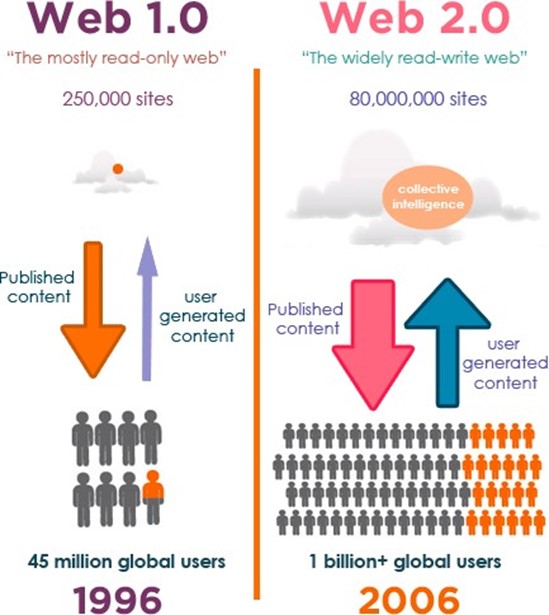It's Personal
Written by John McMahon - Product Director
For those of you that have been working on digital services forever, you’ll remember something called web 2.0. It was dismissed as irrelevant by naysayers back in 2005 but it turned out to be massive. While the layperson may not know what web 2.0 means or stands for they will almost certainly have interacted with a service that was born out of the evolution of internet to “web 2.0”.
Web 2.0 was about a shift toward the democratisation of the web; the facilitation of a more personal, me-focused web. It enabled everyone to create content and share it with a global reach. Importantly, it enabled “individuals to create and distribute content with equal (or at least comparable) power as large corporations”.

Figure 1 - Web 1.0 vs Web 2.0
Examples of, well known web 2.0 applications are:
- Youtube - the birth of video and media creation that spurred on the adoption of 3G/4G
- Facebook - a virtualisation of a friends network with the means to communicate with them all
- Twitter - a place where individuals could comment on politicians and where tweets have left politicians out of a job
- Also Instagram, Wikipedia, Reddit, Flickr, Wordpress
So this movement was about users being able to create content and, overtime, has led to an increased expectation of personalised content. Indeed, providing personalised experiences (and other activity) has led Amazon to become one of the most valuable and still growing companies in the world. McKinsey says it best with the following:
“Highly personalized customer experiences, when offered to millions of individual customers by using proprietary data, are difficult for competitors to imitate. When executed well, such experiences enable businesses not only to differentiate themselves but also to gain a sustainable competitive advantage. Moreover, our research has shown that personalized experiences drive up both customer loyalty and the top line".
But despite this research, Gartner goes on to state that:
It is clear that personalisation increases engagement, conversion to digital and so it is surprising that the execution of this strategy has not been implemented more widely. This is not just a challenge in the private sector either, as while a large proportion of government websites will feature a sign-in of some sort, they do not use data about individuals to dynamically adjust content delivered.
Whilst the drivers for digital transformation and personalisation of digital services in local government are different, citizen engagement and minimisation of operating costs are key; both of which are ameliorated with the effects of personalisation. Local Government Chief Digital and Transformation Officers have seen the importance of implementing a platform that orchestrates data and content from the landscape of applications in councils, and leveraging this to drive personalisation of their digital services is the next logical step.
Council websites and notification services will become more personalised and proactive as technology facilitates it. Indeed, with IEG4’s API framework and its new Broadcast and CitizenVu services, we are providing the tools to enable these personalised and proactive behaviours.
.png?width=3492&name=MicrosoftTeams-image%20(5).png)
Having learned about web 2.0 and the benefits of personalisation, I need to highlight that we are on the cusp of web 3.0 becoming more wide-stream and the advent of the metaverse where decentralisation, democratisation, and personalisation go even further.
The future of the web is bright; it’s personal.
